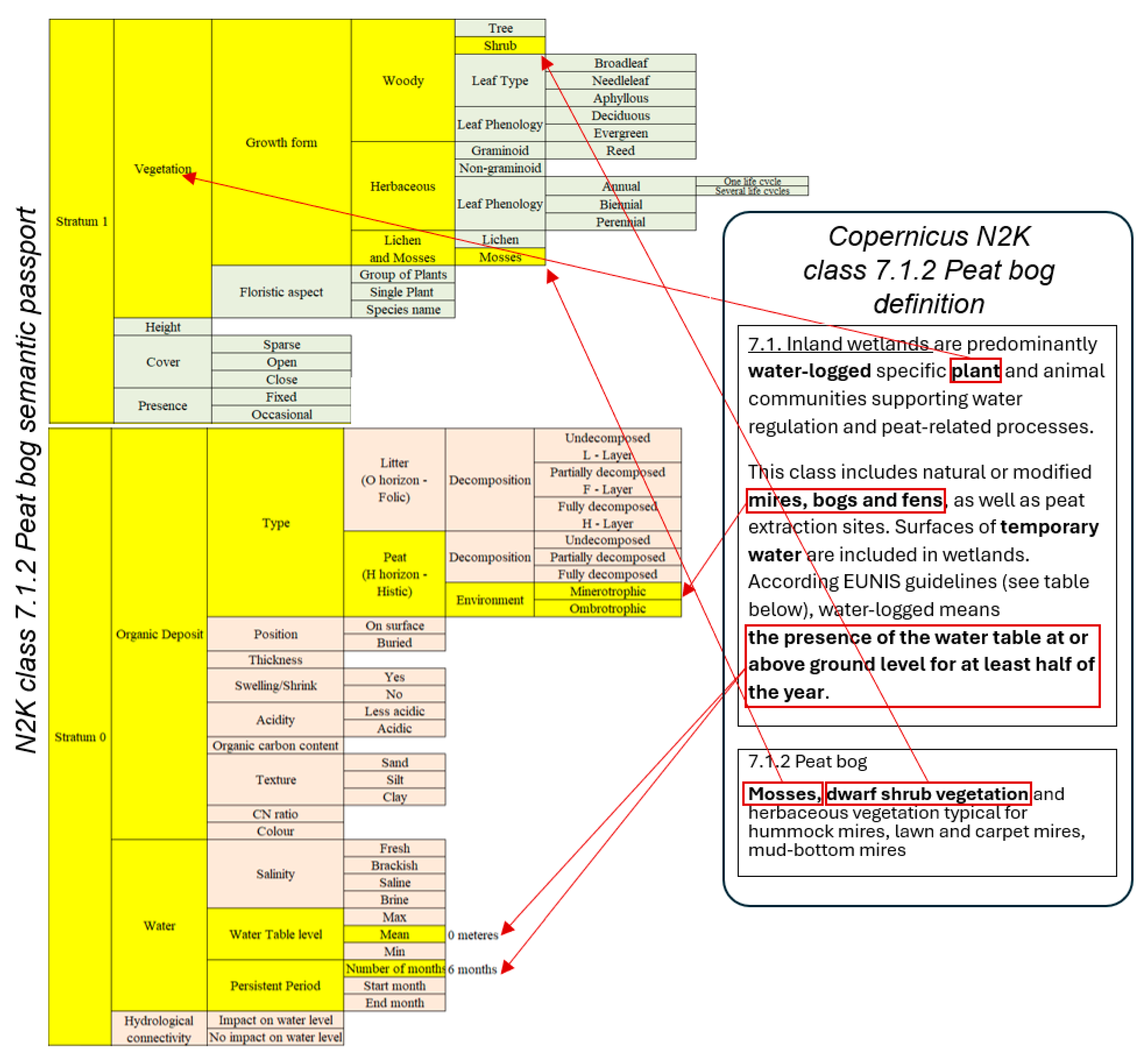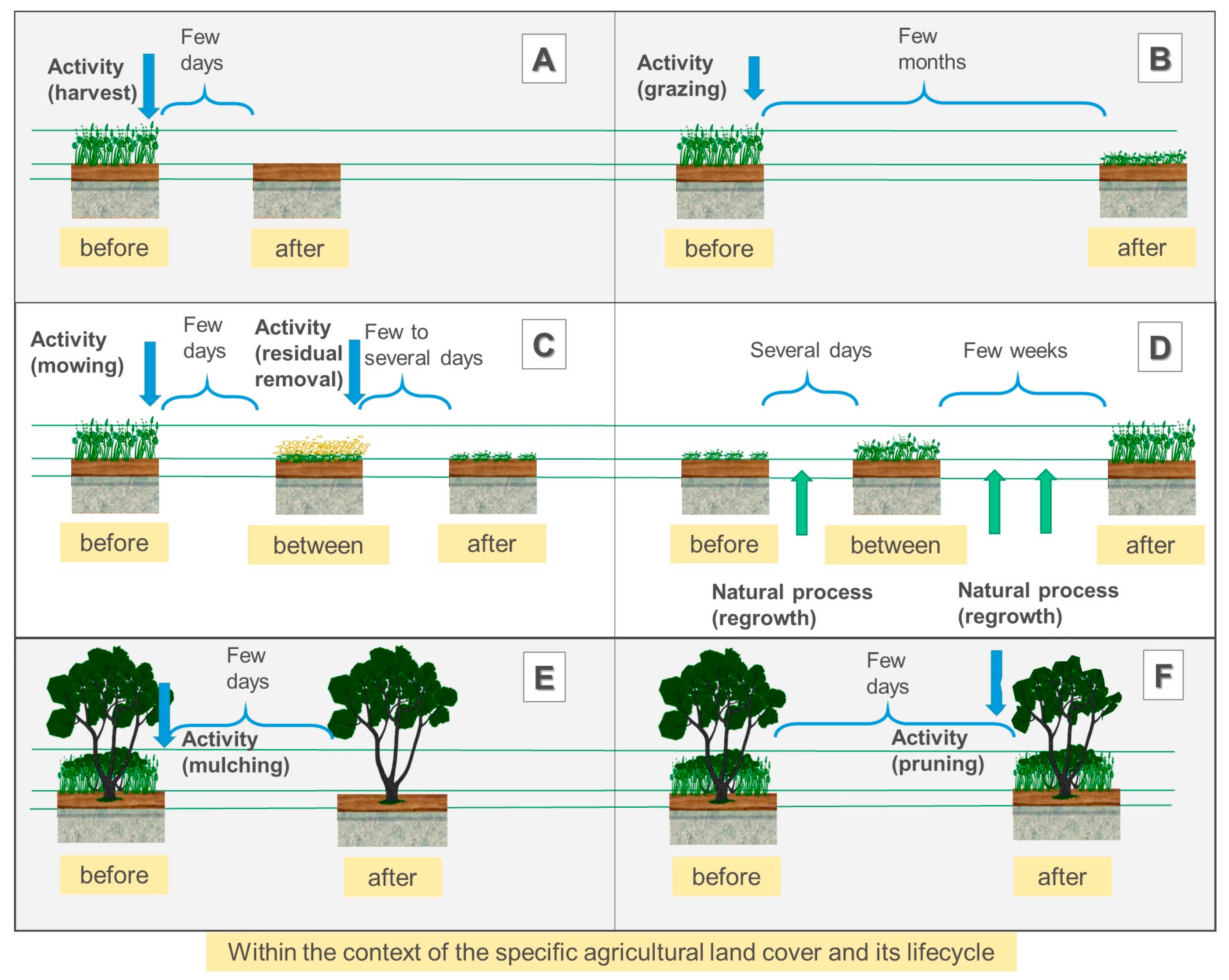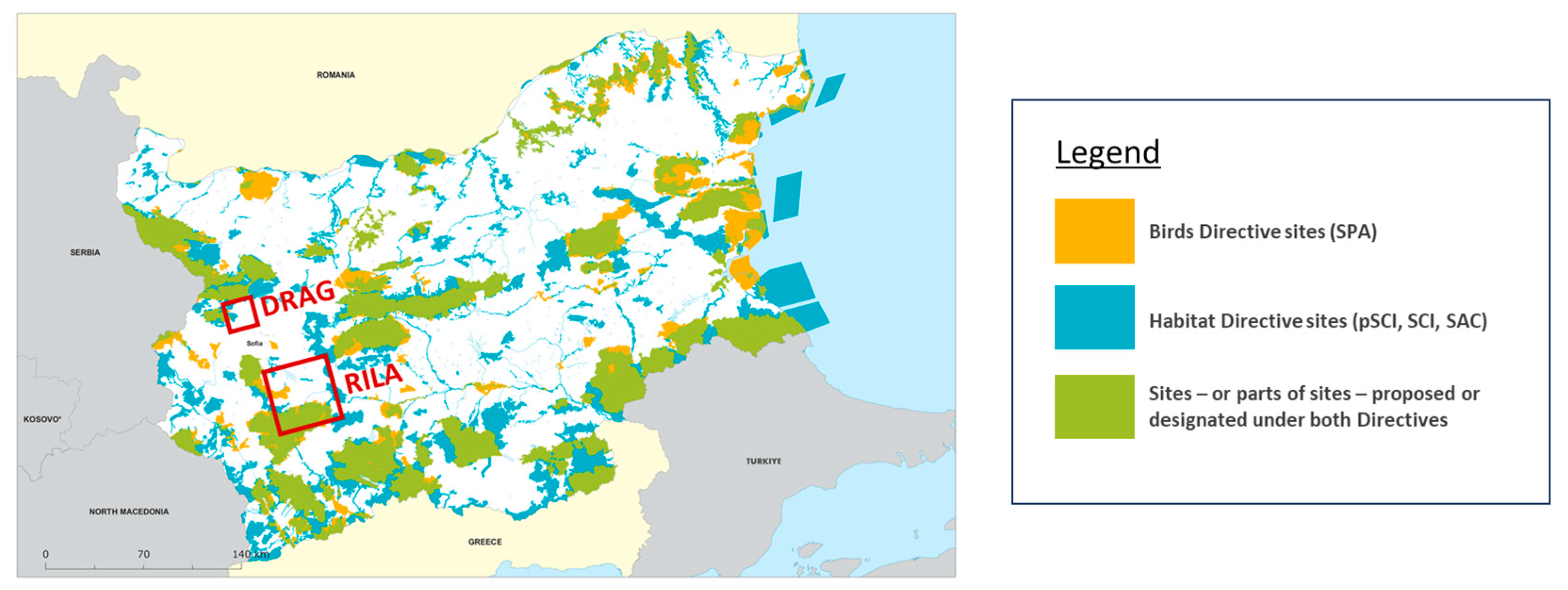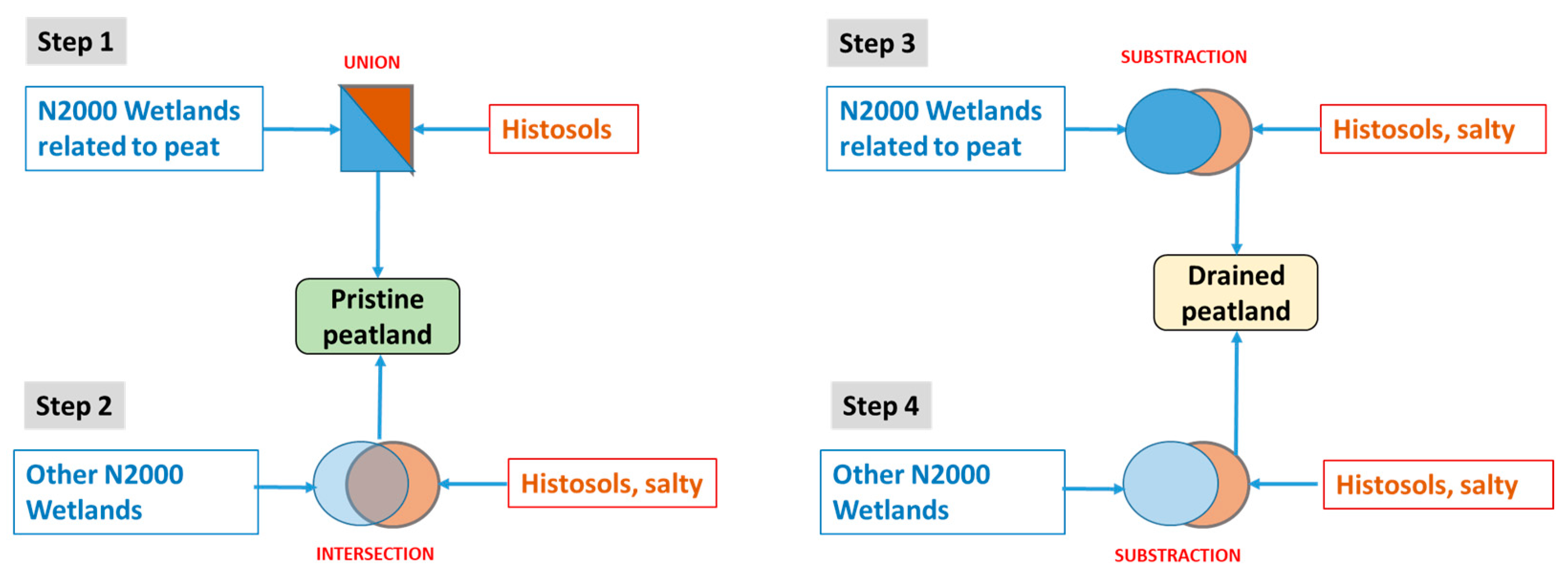Enabling Spatial Data Interoperability through the Use of a Semantic Meta-Model—The Peatland Example from the JRC SEPLA Project
Abstract
:1. Introduction
- (1)
- Catalogue the thematic data (classes and their mapped instances) in the EU Member States that fell into the scope of SEPLA. These are the wetland and peatland areas under cropland and grassland management, as part of the generic land categories, adopted for reporting under LULUCF;
- (2)
- Identify synergies and differences between each Member State’s national geographically explicit dataset based on these definitions;
- (3)
- Compare it with international datasets that can be used to fill gaps in the national data;
- (4)
- Facilitate the selection of the candidate bio-physical characteristics that can be monitored with Earth Observation (EO) technologies.
2. Conceptual Framework
3. Material and Methods
3.1. Design and Demonstration of the Semantic Meta-Model
- Semantic assessment and decomposition of the class definitions, as defined in the related nomenclature. In this step, the textual description of the given class definition is scanned for phrases and key words that relate to elements/characteristics in the meta-model. Once found in the definition, elements/characteristics from the meta-model are flagged and the functional traits between characteristics are highlighted (Figure 4). All classes used to label the objects mapped in a dataset need to be semantically assessed.
- Assessment of the thematic and quantitative information stored in the dataset, associated with each mapped object (structure and type of mapped objects, input sources, and cartographic scale). In this step, the feature data model is queried for the presence of feature types and attributes, corresponding to the semantic meta-model. Here the importance is to identify the type of quantitative information the given dataset contains. Once found in the feature data model, the characteristics from the meta-model are flagged and the functional traits between characteristics are highlighted.
3.2. Extension towards the Temporal Dimension and Land Use
3.3. Implementation Setup of the Semantic Assessment in SEPLA
- Correspondence to LULUCF information needs/requirements;
- Semantic gaps and overlaps (including data availability check);
- Role of the class/dataset in the spatial data integration flow for the generation of the candidate peatland data, in line with the generic categories relevant for the LULUCF reporting;
- Identification of those classes, indicating peatlands at risk or degraded.
4. Results and Discussion
4.1. Results
- (1)
- Generation of the spatial extent of the inland pristine peatlands:
- Step 1: Derive the “union” of the spatial extent of the N2000 wetland classes related to peat with the spatial extent of histosols;
- Step 2: Derive the “intersection” between the spatial extent of any other N2000 wetland classes and the spatial extent of the salty histosols;
- Combine the results of Step 1 and Step 2.
- (2)
- Generation of the spatial extent of the inland drained peatlands:
- Step 3: “Subtract” from the spatial extent of the salty histosols those areas that intersect with the spatial extent of the N2000 wetland classes related to peat;
- Step 4: “Subtract” from the spatial extent of the salty histosols those areas that intersect with the spatial extent of any other N2000 wetland classes;
- Combine the results of Step 3 and Step 4.
4.2. Discussion
5. Conclusions
Author Contributions
Funding
Data Availability Statement
Acknowledgments
Conflicts of Interest
Disclaimer
Acronyms
| CAP | Common Agriculture Policy |
| CbM | Checks by Monitoring |
| EAGLE | Action Group on Land monitoring in Europe of the European environment information and observation network |
| EC | European Commission |
| EEA | European Environmental Agency |
| EO | Earth Observation |
| EU | European Union |
| FOI | Feature of Interest |
| GAEC | Good Agriculture and Environmental Condition |
| GSA | Geo Spatial Application |
| HD | Habitat Directive |
| IACS | Integrated Administration and Control System |
| IPCC | Intergovernmental Panel on Climate Change |
| ISO | International Organization for Standardization |
| JRC | Joint Research Centre |
| LCML | Land Cover Meta Language |
| LC | Land Cover |
| LPIS | Land Parcel Identification System |
| LU | Land Use |
| LUML | Land Use Meta Model |
| LULUCF | Land Use, Land Use Change and Forestry |
| MAES | Mapping and Assessment of Ecosystems and their Services |
| MS | Member State |
| N2000 | Natura 2000 sites network |
| SEPLA | Satellite based mapping and monitoring of European peatland and wetland for LULUCF and agriculture |
| SMU | Soil Map Unit |
References
- Regulation (EU) 2018/841 of the European Parliament of the Council of 30 May 2018 on the Inclusion of Greenhouse Gas Emissions and Removals from Land Use, Land Use Change and Forestry in the 2030 Climate and Energy Framework, and Amending Regulation (EU) No 525/2013 and Decision No 529/2013/EU. Available online: http://data.europa.eu/eli/reg/2018/841/2023-05-11 (accessed on 28 February 2023).
- FAO. Peatland Mapping and Monitoring—Recommendations and Technical Overview; FAO: Rome, Italy, 2020. [Google Scholar] [CrossRef]
- Minasny, B.; Adetsu, D.V.; Aitkenhead, M.; Artz, R.R.E.; Baggaley, N.; Barthelmes, A.; Beucher, A.; Caron, J.; Conchedda, G.; Connolly, J.; et al. Mapping and monitoring peatland conditions from global to field scale. Biogeochemistry 2023. [Google Scholar] [CrossRef]
- Lourenco, M.; Fitchett, J.M.; Woodborne, S. Peat definitions: A critical review. Prog. Phys. Geogr. Earth Environ. 2023, 47, 506–520. [Google Scholar] [CrossRef]
- Charman, D.J. Peat and Peatlands. In Encyclopedia of Inland Waters; Likens, G.E., Ed.; Academic Press: Cambridge, MA, USA, 2009; pp. 541–548. [Google Scholar] [CrossRef]
- Vitt, D.H. Peatlands, Encyclopaedia of Ecology; Academic Press: Cambridge, MA, USA, 2013; Volume 2, pp. 557–566. [Google Scholar] [CrossRef]
- Xu, J.; Morris, P.J.; Liu, J.; Holden, J. PEATMAP: Refining estimates of global peatland distribution based on a meta-analysis. Catena 2018, 160, 134–140. [Google Scholar] [CrossRef]
- Mosca, N.; Di Gregorio, A.; Henry, M.; Jalal, R.; Blonda, P. Object-Based Similarity Assessment Using Land Cover Meta-Language (LCML): Concept, Challenges, and Implementation. IEEE J. Sel. Top. Appl. Earth Obs. Remote. Sens. 2020, 13, 3790–3805. [Google Scholar] [CrossRef]
- Chen, C.; Loft, L.; Matzdorf, B. Lost in action: Climate friendly use of European peatlands needs coherence and incentive-based policies. Environ. Sci. Policy 2023, 145, 104–115. [Google Scholar] [CrossRef]
- European Union. INSPIRE Data Specification on Habitats and Biotopes—Technical Guidelines; European Union: Brussels, Belgium, 2024. [Google Scholar]
- IPCC. 2013 Supplement to the 2006 IPCC Guidelines for National Greenhouse Gas Inventories: Wetlands; Hiraishi, T., Krug, T., Tanabe, K., Srivastava, N., Baasansuren, J., Fukuda, M., Troxler, T.G., Eds.; IPCC: Geneva, Switzerland, 2014. [Google Scholar]
- IUSS Working Group WRB. World Reference Base for Soil Resources 2014, Update 2015 International Soil Classification System for Naming Soils and Creating Legends for Soil Maps; World Soil Resources Reports No. 106; FAO: Rome, Italy, 2015; ISBN 978-92-5-108370-3. [Google Scholar]
- Joosten, H.; Tanneberger, F.; Moen, A.; International Mire Conservation Group. Mires and Peatlands of Europe: Status, Distribution and Conservation; Schweizerbart Science Publishers: Stuttgart, Germany, 2017; ISBN 978-3-510-65383-6. [Google Scholar]
- Tanneberger, F.; Tegetmeyer, C.; Busse, S.; Barthelmes, A.; Shumka, S.; Mariné, A.M.; Jenderedjian, K.; Steiner, G.M.; Essl, F.; Etzold, J.; et al. Mires and Peat; International Mire Conservation Group and International Peatland Society: Klagenfürt, Austria, 2017; Volume 19, Article 22; pp. 1–17. [Google Scholar] [CrossRef]
- Bragg, O.; Lindsay, R. (Eds.) Strategy and Action Plan for Mire and Peatland Conservation in Central Europe; Publication No. 18; Wetlands International: Wageningen, The Netherlands, 2003; p. 94. Available online: https://www.wetlands.org/publication/strategy-and-action-plan-for-mire-and-peatland-conservation-in-central-europe/ (accessed on 18 October 2023).
- Jandl, R.; Rodeghiero, M.; Martinez, C.; Cotrufo, M.F.; Bampa, F.; van Wesemael, B.; Harrison, R.B.; Guerrini, I.A.; deB Richter, D., Jr.; Rustad, L.; et al. Current status, uncertainty and future needs in soil organic carbon monitoring. Sci. Total Environ. 2014, 468–469, 376–383. [Google Scholar] [CrossRef] [PubMed]
- Keddy, P.A. Wetland Ecology: Principles and Conservation; Cambridge University Press: Cambridge, UK, 2010. [Google Scholar] [CrossRef]
- Heimlich, R.; Wiebe, K.; Claassen, R.; Gadsby, D.; Robert, M. Wetlands and Agriculture: Private Interests and Public Benefits, Resource Economics Division, Agricultural Economic Reports 34043; Report No. 765; United States Department of Agriculture, Economic Research Service: Washington, DC, USA, 1998. [Google Scholar] [CrossRef]
- ISO 19144-2:2023; Geographic Information—Classification Systems—Part 2: Land Cover Meta Language (LCML). ISO: Geneva, Switzerland, 2023.
- Arnold, S.K.; Smith, G.; Perger, C.; Mancosu, E. Explanatory Documentation of the EAGLE Concept, Version 3.2; European Environmental Agency: Copenhagen, Denmark, 2023. [Google Scholar]
- Devos, W. LPIS Quality Inspection: EU Requirements and Methodology; JRC 65646; European Commission, Joint Research Centre: Luxembourg, 2011. [Google Scholar]
- Devos, W.; Milenov, P. Land Use and Land Cover Semantics—Principles, Best Practices and Prospects; (Vols. Applying tegon, the elementary physical land cover feature, for data interoperability); CRC Press: Boca Raton, FL, USA, 2015. [Google Scholar] [CrossRef]
- Banov, M.; Kolev, N.; Milenov, P. Technological framework for precise management of the system “soil-plants-ground atmosphere”. Bulg. J. Agric. Sci. 2021, 27, 575–581. [Google Scholar]
- Nomenclature and Mapping Guideline. Copernicus Land Monitoring Service Local Component: N2K Mapping, Issue 1.4 (2021). Available online: https://land.copernicus.eu/en/technical-library/n2k-2006-2012-2018-nomenclature-and-mapping-guidelines/@@download/file (accessed on 3 April 2023).
- Zielinski, R.; Milenov, P.; Sima, A.; Devos, W. Structured Template for Documenting Agricultural Land Monitoring Systems, Ispra, JRC130662; JRC: Ispra, Italy, 2022. [Google Scholar]
- Ivanova-Stoyanova, R.; Stoeva, L. Methodological Report on Resolving Interoperability Issues in Reusing IACS Data in LULUCF, JRC External Report; EU: Brussels, Belgium, 2021. [Google Scholar]
- Kavrukova, V.; Dimova, D.; Dimitrov, M.; Tzonev, R.; Belev, T.; Rakovska, K. (Eds.) Manual for Identification of Habitats of European Conservation Significance; Second revised and supplemented edition, WWF Danube Carpathian Program and Green Balkans; Geosoft EOOD: Sofia, Bulgaria, 2009; ISBN 978-954-9433-08-1. [Google Scholar]
- Shishkov, T.; Kolev, N. The Soils of Bulgaria; Springer Science + Business Media: Dordrecht, The Netherlands, 2014. [Google Scholar] [CrossRef]
- Gyurov, G.; Artinova, N. Soil Science, Second Edition, Sofia; Intelexpert-94 Ltd.: Plovdiv, Bulgaria, 2015; ISBN 978-619-7220-01-8. [Google Scholar]
- Milenov, P.; Vajsova, B.; Voican, G.; Acquafresca, L.; Anastasakis, K.; Lemoine, G. Assessing the Validity of the Feature of Interest in the Context of the CAP Checks by Monitoring, Ispra, JRC123711; JRC: Brussels, Belgium, 2021. [Google Scholar]













Disclaimer/Publisher’s Note: The statements, opinions and data contained in all publications are solely those of the individual author(s) and contributor(s) and not of MDPI and/or the editor(s). MDPI and/or the editor(s) disclaim responsibility for any injury to people or property resulting from any ideas, methods, instructions or products referred to in the content. |
© 2024 by the authors. Licensee MDPI, Basel, Switzerland. This article is an open access article distributed under the terms and conditions of the Creative Commons Attribution (CC BY) license (https://creativecommons.org/licenses/by/4.0/).
Share and Cite
Milenov, P.; Sima, A.; Lugato, E.; Devos, W.; Loudjani, P. Enabling Spatial Data Interoperability through the Use of a Semantic Meta-Model—The Peatland Example from the JRC SEPLA Project. Land 2024, 13, 473. https://doi.org/10.3390/land13040473
Milenov P, Sima A, Lugato E, Devos W, Loudjani P. Enabling Spatial Data Interoperability through the Use of a Semantic Meta-Model—The Peatland Example from the JRC SEPLA Project. Land. 2024; 13(4):473. https://doi.org/10.3390/land13040473
Chicago/Turabian StyleMilenov, Pavel, Aleksandra Sima, Emanuele Lugato, Wim Devos, and Philippe Loudjani. 2024. "Enabling Spatial Data Interoperability through the Use of a Semantic Meta-Model—The Peatland Example from the JRC SEPLA Project" Land 13, no. 4: 473. https://doi.org/10.3390/land13040473




